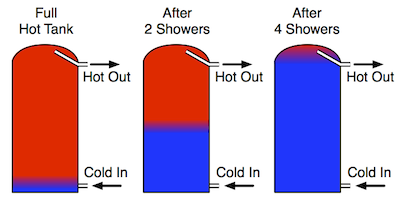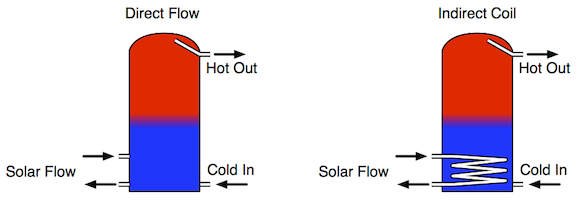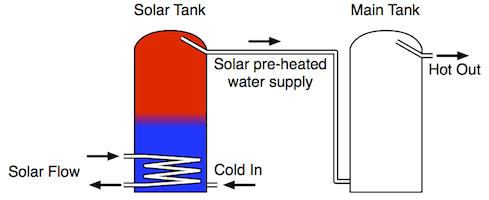Feb 19th, 2018
Nov 12th, 2015
Solar Hot Water Basics
Water Heating Basics
- 1kWh of heat energy can heat about 30 Litres / 7.5 US gallons of water up from cold to showering temperature.
- A household of 5 people will use between 10-15kWh of energy each day to heat water (not including space heating).
- In the winter more energy is needed to heat water as the cold water is colder, and people often have longer and hotter showers than in the summer.
- Water is normally heated by electricity or gas, but solar can be used to offset between 50-90% of this energy.
Storing Hot Water
The most common hot water system involves heating and then storing hot water in a tank. When hot water is used, it is drawn from the top of the tank, where the water is the hottest, and fresh cold water is delivered into the bottom of the tank. Because hotter water is lighter and sits above colder water, it is realistic to see a tank that has bottom half cold and the top half hot... this is referred to as thermal layering, or stratification. Eventually after enough hot water usage the water suddenly turns cold, which is something everybody has probably experienced! 
Tanks are designed to enhance thermal layering to maximise hot water supply by reducing turbulence when the cold water enters the tank.

Solar Tank Design
The performance of a solar collector is highest when heating cold water. As the temperature of the water increases the efficiency of the solar collection will drop, the amount of performance loss depending greatly on the type and quality of the collector. For this reason thermal layering is important in a solar storage tank, ensuring that solar is always heating the coldest water possible.
Given that the coldest water is in the bottom of the tank, the solar heating is always in the bottom area, either direct flow or with a coil heat exchanger.

Ideally a dedicated solar tank should be used which then feeds a primary tank with solar pre-heated water. This format is ideal when retrofitting to an existing system as does not require any major changes to the plumbing layout. The cold supply is fed into the solar tank, and the solar tank outlet feeds the cold inlet of the main tank. Having a dedicated volume of water for the solar to heat eliminates competition from the existing energy source, which would happen if the tank was also heated by electricity, gas etc (unless timer or manual boosting control is used).


How Solar Collectors Heat Water
The question is often asked “How much hot water will I get”, or “What temperature is the water from the solar collector”. Neither of these questions are possible to answer directly, as some additional information is needed.
Firstly, in most applications, solar does not heat the water in a single pass like a tankless gas heater would. The solar collector heats the water gradually throughout the day, normally by about 10oC / 18oF each pass. The flow rate through the collector is also quite slow, around 3L/min / 0.8gpm for an average domestic sized system.
Over a 10 hour period in the summer in most parts of the world, an Apricus AP-30 collector can provide in excess of 10kWh of energy with the peak output of the collector reaching as high as 2kW during the hottest and sunniest parts of the day.
How Much Hot Water?
So how much hot water will a solar collector give you? To answer this question fairly, one variable must be fixed, either temperature rise or volume of water.
The following examples use a nominal heat value of 10kWh. The actual output of the collector depends on the size, time of the year and other factors.
Set Temperature Rise
If raising cold water by 30oC / 54oF to a suitable showering temperature:
10kWh can provide about 285 Litres / 75 US gallons of hot water.
Set Volume
Temperature rise for 200 Litres / 53 US gallons of cold (15oC / 60oF) water:
10kWh will heat the water to about 58oC / 136oF
So a much better question to ask is "How much showering temperature hot water will this collector give me in summer?". That is a questions that a solar professional should be able to answer confidently based on a specific collector model, system configuration and you local climate.














